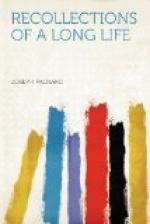“A pair of friends, though
I was young,
And he was seventy-four.”
From the rear of his court-yard he showed me Rydal Water, a little lake about a mile long, the beautiful church, and beyond it, Grassmere, and still further beyond, Helvelyn, the mountain-king with a retinue of a hundred hills. I might have spent the whole day in delightful intercourse with the old man, but my fellow-travellers were going, and I could make no longer inroads upon their time. When we returned to the door of his cottage, he gave me a parting blessing; he picked a small yellow flower and handed it to me, and I still preserve it in my edition of his works, as a relic of the most profound and the most sublime poet that England has produced during the nineteenth century I know of but one other living American who has ever visited Wordsworth at Rydal Mount.
After passing through Keswick, where the venerable poet Southey was still lingering in sadly failing intelligence, we reached Carlisle the same evening. From Carlisle we took the mail-coach for Edinburgh by the same route over which Sir Walter Scott was accustomed to make his journeys up to London. The driver, who might have answered to Washington Irving’s description, pointed out to me Netherby Hall, the mansion of the Grahams, on “Cannobie lea,” over which the young Lochinvar bore away his stolen bride. We passed also Branksome Tower, the scene of the “Lay of the Last Minstrel,” and reached Selkirk in the early evening. The next day I spent at Abbotsford. The Great Magician had been dead only ten years, and his family still occupied the house with some of his old employees who figure in Lockhart’s biography. I sat in the great arm-chair where Sir Walter Scott wrote many of his novels, and looked out of the window of his bedchamber, through which came the rippling murmurs of the Tweed, that consoled his dying hours. I heartily subscribe to the opinion, expressed by Tennyson, that Sir Walter Scott was the most extraordinary man in British literature since the days of Shakespeare.
After reaching Glasgow I made a brief trip into the Land of Burns. At the town of Ayr I found an omnibus waiting to take me down to the birthplace of the poet. At that time the number of visitors to these regions was comparatively few, and the birthplace of the poet had not been transformed, as now, into a crowded museum. On reaching a slight elevation, since consecrated by the muse of Burns, there broke upon the view his monument, his native cottage, Alloway Kirk, the scene of the inimitable Tam o’ Shanter, and behind them all the “Banks and Braes of Bonnie Doon.” I went first to the monument, within which on a centre table are the two volumes of the Bible given by Burns to Highland Mary when they “lived one day of parting love” beneath the hawthorn of Coilsfield. One of the volumes contains, in Burns’ handwriting, “Thou shalt not forswear thyself, but shalt perform unto the Lord thy vows,” and a lock of Mary’s




